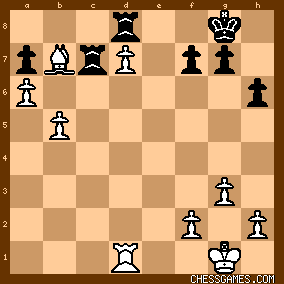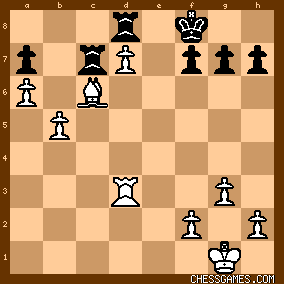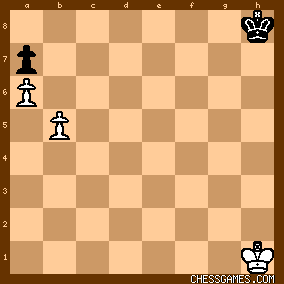|
< Earlier Kibitzing · PAGE 2 OF 3 ·
Later Kibitzing> |
| Mar-03-10 | | patzer2: <Billy Vaughan: Bc6 or Bc8 look like they might win, but b6 seems the surest way.> If 34. Bc6, then 34...Kf8 35. f4  wins but it's difficult and slow. Even more difficult is 34. Bc6 Kf8 35. Re1 Rcxd7 36. Bxd7 Rxd7 37. Ra1 wins but it's difficult and slow. Even more difficult is 34. Bc6 Kf8 35. Re1 Rcxd7 36. Bxd7 Rxd7 37. Ra1  . . |
|
| Mar-03-10 | | gofer: Well I am tempted by Bc6 and b6. I thought that Bc6 was the most threatening as
it allows Re8 at some point and there is nothing that black can do about it! So it
is a huge nail in black's coffin.
34 Bc6
if Rd8 moves on the 8th rank then d8=Q Rxd8 Rxd8 wins the rook
if Rdxd7 Rxd7 wins
if Rcxd7 Rxd7 wins
if Rxc6 bxc6 wins
So now the rooks are trapped. Only King moves are available. If the King comes to
e7 then he cannot go any further and swapping off on d7 loses to Rxd7 Rxd7+ Rxd7
Bxd7 Kxd7 b6 axb6 a7, so the white rook simply comes to e3 to allow the white king
to walk all the way round the board to c5 at which point Pb5-b6 wins. So this is what I would have chosen OTB. But as its a puzzle and that conclusion is
too deep for wednesday I had a closer look at 34 b6 and its a killer! The back rank
mate threat means that white can sacrifice everything! 34 b6 ...
and black resigns!
34 ... Rcxd7
35 Rxd7 Rxd7
36 bxa7 winning
34 ... axb6
35 a7 Rxb7
36 a8=Q and its all over the only way to stop mate is to play g7 37 Qxd8+ Kg7 38 Qd8 which is hopeless! Time to check... |
|
| Mar-03-10 | | A Karpov Fan: this is too easy for a Wednesday by far, white has one active plan and the most obvious move is also the correct one. Monday level imo. |
|
| Mar-03-10 | | whiteshark: 34.b6 axb6 35.a7 is winning. The black rooks are completely helpless.
<AKF> Yes, M-T level. |
|
| Mar-03-10 | | whiteshark: Even with an additional move - ♙h6 for a flight square on h7 - black is lost. 
click for larger view But it requires some technique: <34.Bc6 Kf8 35.Re1 Rcxd7 36.Bxd7 Rxd7 37.Rc1 Ke7 38.Rc8 Kd6 39.Kg2> 
click for larger view |
|
| Mar-03-10 | | whiteshark: Maybe it's gonna be an 8 days week? |
|
| Mar-03-10 | | TheaN: Wednesday 3 March 2010
<34.?>
Target: 2:10;000
Taken: N/A*
*: looked at this position for ~1:45, didn't see it and had to leave. Whilst I was doing something else I recalled the position and did find the solution, blind. Material: unbalanced, White ♗+2♙ / ♖
Candidates: Re1, Bc6, Bc8... <[b6]> -ML-
Purely on what does NOT work did I solve this puzzle. 34.Re1 is obvious: it threatens 35.Re8†. However, the d-pawn's defense was already fragile and now it is gone: 34....Rcxd7  wins for Black. wins for Black. 34.Bc6 protects d7 and seems to give Black major headaches but it is perfectly defendable: of course the threat is Re1 now, having defended d7 extra, so Black should now par the threat partly with 34....Kf8! 35.Re1 Rcxd7! 36.Bxd7 Rxd7  and with the bank rank threat gone the win is going to be a tedious struggle; not something for a Wednesday puzzle. and with the bank rank threat gone the win is going to be a tedious struggle; not something for a Wednesday puzzle. 34.Bc8, on the account of the remaining position, may see the same as after Bc6 but now 34....Rcxc8 is of course also playable (34.Bc6 Rcxd7? 35.Bxd7  due to back rank mate) 35.dxc8=Q Rxc8 due to back rank mate) 35.dxc8=Q Rxc8  . . So. With the immediate threat of Rcxd7, White has to do something. It seems I've had pretty much all important moves. Except for one. If one passed pawn does not win: sac a blocked one to create two! <34.b6!> this threatens the pawn on a7 (and the Rook on c7), and as such negates Rcxd7: /A\
<34....Rcxd7 35.Rxd7 Rxd7 36.bxa7  > just moving the Rook obviously also leads to bxa7, and due to the d and a-pawns Black cannot defend even with two Rooks. So, capturing is forced. > just moving the Rook obviously also leads to bxa7, and due to the d and a-pawns Black cannot defend even with two Rooks. So, capturing is forced. /B\
<34....axb6> okay, two passed pawns. It shows that two passed pawns and a Rook can be stronger against two Rooks than a Rook and Biship and one passed pawn. In this position it is because of the back rank threats. Well, what do we do with passed pawns? Me move em. <35.a7!> this is where I was stuck on in the first 1:45, oddly enough. Black's alternatives are nil, with the Bishop defending a8. In fact, that doesn't even matter, after 35....Rcxd7 36.Rxd7 Rxd7 37.a8=Q† 1-0 it leads to mate even without the Bishop. That actually already gives away that the position is winning without the Bishop: <35....Rxb7 36.a8=Q  > and mate or enormous material loss to follow. The key back rank mating combinations are 36....Rxa8 37.d8=Q† Rxd8 38.Rxd8‡ 1-0, 36....Rbb8 37.Qxb8 > and mate or enormous material loss to follow. The key back rank mating combinations are 36....Rxa8 37.d8=Q† Rxd8 38.Rxd8‡ 1-0, 36....Rbb8 37.Qxb8  Rxb8 38.d8=Q† Rxd8 39.Rxd8‡ 1-0, and 36....Rbxd7 37.Qxd8† Rxd8 38.Rxd8‡ 1-0. Any mate-defending move leads to the loss of at least a Rook, with the White Queen AND pawn d7 still on the board. A nice Wednesday, perhaps a tad bit easy as most of it is forced. Time to check. Rxb8 38.d8=Q† Rxd8 39.Rxd8‡ 1-0, and 36....Rbxd7 37.Qxd8† Rxd8 38.Rxd8‡ 1-0. Any mate-defending move leads to the loss of at least a Rook, with the White Queen AND pawn d7 still on the board. A nice Wednesday, perhaps a tad bit easy as most of it is forced. Time to check. |
|
| Mar-03-10 | | gofer: When I wrote "so the white rook simply comes to e3", I meant "so the white rook simply comes to d3"... 34 Bc6 Kf8
35 Rd3 ...

click for larger viewThen the king marches... Kf1, Ke2, Kd2, Kc3, Kc4, Kc5 |
|
| Mar-03-10 | | zb2cr: Oh bah. I only looked at the puzzle superficially and concluded that 34. Bc6 was the right way. |
|
| Mar-03-10 | | wordfunph: not too obvious move 34.b6! |
|
| Mar-03-10 | | eric the Baptist: This was easier than Monday or Tuesday. |
|
Mar-03-10
 | | gawain: I agree with those who said that this was too easy for a Wednesday. Or maybe I am just getting smarter! |
|
| Mar-03-10 | | desiobu: I also found this one easier than yesterday's. |
|
| Mar-03-10 | | Patriot: I found the solution 34.b6! pretty quickly and took a little more time making sure it works. This is a good example that whenever pawns are advanced, look at ways to push them. The potential for tactics increase as pawns get further down the board. Last night, while watching an OTB 10-minute game, I noticed that black had a pawn on the 6th rank which was over-protected by doubled rooks and blockaded by the white queen. White moved his knight, attacking the queen, and I instantly saw that 1...QxR! 2.QxQ e2 pushes the pawn through without counterplay. Black assumed that he couldn't take the rook, so he moved it to a safe square. White kept giving black the opportunity, move after move, to take the rook but he didn't. Sure, it was only a 10-minute game and black had about four minutes left and I had the advantage of being an onlooker with no time pressure but I have to believe that if black had a more efficient thought process (look at forcing moves first and realize that tactics potential is high with advanced pawns) he would have seen it. Or familiarity with that pattern would have helped as well. |
|
| Mar-03-10 | | turbo231: Some people say that today's puzzle was easier than Tuesday's, maybe... maybe not. I think the critical move to set up the end game was that you had to take the rook at a8 (a7=Queen RookxQa8 Bb7xRa8)with the bishop. If you do that you end up with a rook and a bishop and black ends up with nothing. Because you can't get mate right away, the King will drop a pawn to make room for a escape. Or more likely move over to f8. By taking the rook with the bishop that forces the rook at c7 to take the pawn at d7,( or the pawn at c7 will promote to Queen, and there's nothing black can do about it). That's how you end up with a rook and a bishop and black ends up with nothing but 4 pawns. And the King will be blocked out by the Rook at d7. A very easy end game. Now i'm going to take this knowledge and play Rybka. |
|
| Mar-03-10 | | SetNoEscapeOn: This was easy because there weren't even any other tactical possibilities in the position; there is literally nothing else to calculate except b6. |
|
| Mar-03-10 | | patzer2: The two key moves turning the game in White's favor are: 22. d4!  , advancing a potential passer and blocking the Bishop's attack on f2, and , advancing a potential passer and blocking the Bishop's attack on f2, and 23. a5!  , exchanging a Rook for a Bishop and two pawns -- which in general calculations is an even trade, but in this position, with a couple of potential passers, proves to be decisive. , exchanging a Rook for a Bishop and two pawns -- which in general calculations is an even trade, but in this position, with a couple of potential passers, proves to be decisive. |
|
| Mar-03-10 | | SuperPatzer77: <patzer2>: <If 34. Bc6, then 34...Kf8 35. f4 wins but it's difficult and slow. Even more difficult is 34. Bc6 Kf8 35. Re1 Rcxd7 36. Bxd7 Rxd7 37. Ra1 .> <patzer2> You're absolutely right. 34. b6! leads to the rank mate or the material advantage. In my opinion, 34. b6! is much simpler and faster than 34. Bc6 or Bc8. It gives White strong tactics when it is Zoltan Ribli's move - 34. b6!. 34. b6! axb6, 35. a7 Rxb7, 36. a8=Q below:
a) 36...Rxd7, 37. Qxd8+! Rxd8, 38. Rxd8#
b) 36...Rbb8, 37. Qxb8! Rxb8, 38. d8=Q+ Rxd8, 49. Rxd8# c) 36...Rxa8, 37. d8=Q+ Rxd8, 38. Rxd8#
1-0
SuperPatzer77 |
|
| Mar-03-10 | | YouRang: I missed the quick win 34...b6. Instead, I became infatuated with how wonderfully 34...Bc6 locks up black's rooks, even though Black can give back the exchange and accept a pawn-down endgame. Still, I think white can win that ending because of the far advanced pawns. Anyway, 34...b6 is clearly the quick and certain win -- a well-deserved prize for people who don't just jump at the first move that interests them. |
|
Mar-03-10
 | | doubledrooks: <zooter> wrote: <Amazing stuff and no wonder I'm addicted to chess.> Great comment, <zooter>. As for today's problem, 34. b6 threatens to open a path for the white a pawn to head to a8 after 34...axb6, leaving black lost in all variations. |
|
Mar-03-10
 | | chrisowen: Polished type of composition, Zoltan could allez the queenside passer. Does a6 pawn think I am a deus ex machina? Wolgang cranes his neck with 33..Rc7 yet the key b5 - b6 is the trap door. He belies his experience with 27..Rc4 when 27..Qb2 threatening Qxb4 looks more ave verum corpus. In a lot of this plot it is the a7/d7 devices that score it for him. |
|
| Mar-03-10 | | turbo231: I meant to say the rook at c7 has to take the pawn at d7 or the pawn at (d7) will queen and black can do nothing about it. I played Rybka i thought rybka would move to the king to f8 but she dropped a pawn. It didn't matter the game ended up the same way. White had a rook and bishop, black had 4 pawns. Of coarse the first move is b6. |
|
Mar-03-10
 | | Jimfromprovidence: <Random Visitor> indicated that 27 b6 wins. That move looks good, it's a more complicated version of today's puzzle. On that same note it appears white erred with 27 d5?!, allowing 27...Qb2, (threatening the white bishop), which black did not pick up on.

click for larger viewThe question is can white sacrifice the bishop and still play 28 b6? |
|
| Mar-03-10 | | Once: Sometimes you've got to feel a little sorry for the humble prawn. As most chess tactics involve a double attack, the poor lumbering foot soldier just can't compete. A prawn can't pin, can't skewer and can only just about fork ... and then only if the opponents stand in exactly the right spot... But like the Zulus at Rourke's Drift, prawns do have one advantage over the better armed aristocrats of the chess boards - numbers. What prawns lack in firepower, they can sometimes make up for by bringing along a friend or two. Today's puzzle relies on two fairly standard pawn promotion tricks. Here's the first one: 
click for larger viewThe black a7 pawn seems to hold back both white pawns, but this is just an illusion. With 1. b6, white creates a double threat - he will either crown the b pawn (if black does nothing) or 1...ab 2. a7 and the a pawn queens. The second trick is this one:

click for larger viewAgain, the black rook seems to have it all under control but is quickly overwhelmed by pawn numbers. 1. a8=Q Rxa8 2. d8=Q. One pawn could be held back, but two are deadly. Combining these two motifs, and chucking in the extra bishop and rook, and we get today's pleasing little puzzle where the pawn Zulus overrun the British soldiders led by Stanley Baxter and Michael Caine. BTW, one of my favourite promotion tricks is this one: 
click for larger viewBlack cannot prevent white from queening one of the pawns. Even if we give black two consecutive moves, he still cannot prevent a pawn from queening. So perhaps the humble prawn is not so humble after all. And let's not forget that the Zulus may have been unable to win at Rourkes Drift, but they were rather more successful at the battle of Isandlwana just a few hours before... |
|
| Mar-03-10 | | hedgeh0g: The fact that the position was so simple made this puzzle even easier than usual. A simple glance at White's advanced queenside, coupled with Black's tied-up rooks and weak back rank leaves b6! as the breakthrough move. |
|
 |
 |
|
< Earlier Kibitzing · PAGE 2 OF 3 ·
Later Kibitzing> |





































